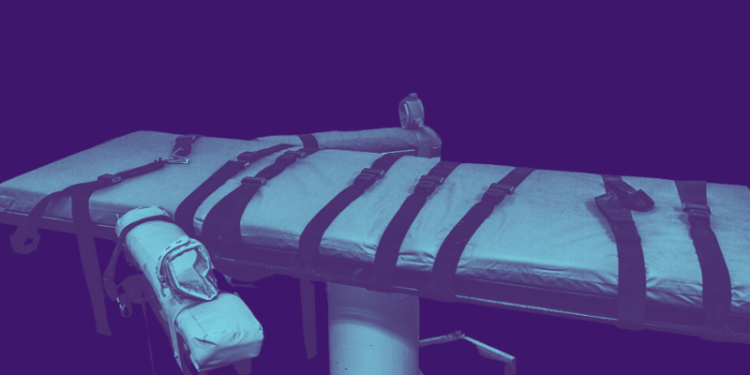Michael Tisius was executed on Tuesday, June 6, 2023. There was international opposition to his execution while he spent 23 years on death row waiting to die.
He had no criminal record. He was 19, not a mentally competent adult when he killed two jailhouse guards as he tried to help his 27-year-old cellmate escape after Tisius had been released for a minor offense. He was a severely abused child similar to a large percentage of death row inmates.
The American Bar Association, the NAACP, the European Union, The Vatican, 6 jurors, and 2 alternates from his original trial opposed his execution.
Twenty-six years ago, I covered a Texas execution, the circumstances of the execution were much different than that of Tisius but the inhumanity I witnessed will never die.
Tuesday, December 9, 1997:
An inmate is strapped down crucifixion style on a gurney in the death chamber of a Texas prison and I’m the reporter in the witness box assigned to cover his execution.
Michael Lee Lockhart raped and disemboweled two teenage girls, one in Indiana in November 1987, the other in Florida in January 1988. In March 1988, he shot a Texas police officer twice to ensure he was dead when the officer tried to arrest him.
The families of his victims are pressed against a large window in the witness box waiting for his execution.
Outside, two busloads of Texas cops are standing in the prison parking lot, squirting whiskey they call “joy juice” out of syringes into their mouths.
A prison chaplain, Minister Jim Brazzil stands beside Lockhart and places his hand on his ankle, the only exposed part of Lockhart’s body aside from his arms. IV needles are inserted in veins near his elbows. The chaplain is there to comfort Lockhart until he’s dead.
Brazzil, the Huntsville Unit chaplain at the time told the Houston Chronicle 4 years later in 2000 that when a condemned man stops breathing “sometimes you can feel the spirit leave”
The warden asks Lockhart for a final statement. He apologizes to the victim’s families, thanks prison officials for their kindness and forgives his executioner.
“That’s all warden, I’m ready.”
The warden signals the executioner. The lethal injection begins. Lockhart stops moving or talking and looks at peace. A high school friend of his on the other side of the witness room wall starts screaming while the victim’s families are unmoved.
The victim’s family stares at Lockhart until he’s pronounced dead. They leave the witness box smiling. On their way to the death chamber, I saw them smiling and joking.
I move closer to the window. Lockhart’s body is a strange shade of blue. Prison officials say there’s no oxygen in his corpse. I wonder if his death was peaceful.
At the TV station, my live report at the top of the 10 o’clock news is a straightforward account of Lockhart’s crimes and execution (I left out the police and victim family reactions.)
I was married and still am to a formerly incarcerated man who once had the death penalty after a wrongful conviction when he was 20. I opposed executions and I believed Lockhart was mentally ill so there is a chance my personal feelings might have crept into my report, violating journalistic standards and ethics.
I interviewed Lockhart six months before he was executed. He said he checked himself into an Ohio mental hospital in 1984 because he thought about suicide and he was afraid of “hurting someone else.” He said his family was embarrassed and had him released from the facility.
I was reared a Catholic. The death penalty violates Christianity’s teachings about forgiveness. “Forgive us our trespasses as we forgive those who trespass against us.” Jesus forgave those who crucified him: “Forgive them, Father, they know not what they do.,” Luke 23:34.
In 2001, I learned lethal injections could be brutal. The New York Times reported veterinarians weren’t using lethal injections to euthanize dogs due to their horrific side effects. I think how Lockhart might have been paralyzed, unable to move or scream as he suffocated over long minutes until the third drug stopped his heart.
Autopsy reports in an investigation of 200 prisoners, executed in nine states between 1990 and 2019, confirmed the findings. They found “pulmonary edema in 84% of the cases.” It creates “the same panic and terror as drowning like the torture tactic of waterboarding.”
Lockhart might have endured another form of torture as prison officials prepared him to die, searching his body for suitable veins to insert IV needles.
in July of 2022, It took Alabama prison officials 3 hours to find a suitable vein to execute Joe Nathan James, the longest recorded case of a botched lethal injection execution in the United States. Other condemned inmates have also endured needles and cuts over prolonged periods.
Perhaps it hadn’t taken long to insert needles in Lockhart’s arms. But he wasn’t sedated to relieve his pain, anxiety or fear. Texas protocol forbids using tranquilizers before an execution. Prisoners fight fear wide awake as long as it takes to find the right vein to inject the deadly drugs and then die.
Since 1973, at least 190 people with death sentences have been wrongly convicted. Posthumous pardons have lists of innocent and wrongly convicted people put to death.
In 1951, seven young black men charged with raping a white woman were killed in “the largest mass execution for rape in U.S. history.” They had no lawyers and were threatened with being released to a lynch mob if they didn’t confess.
In Georgia, a Black woman was pardoned 60 years after her execution for shooting a white man who threatened her. The Death Penalty Information Center lists 5 more exonerations after innocent people were hung or electrocuted.
The death penalty’s racist history violates the U.S. Constitution’s mandate that all men are created equal. The U.S. Supreme Court overturned it nationwide in 1972, ruling under the 8th and 14th Amendments that it was not inequitably applied. “It was being “imposed on some individuals but not others with no valid justification for the difference …” making it “unconstitutionally cruel.” Twenty-seven states still have the death penalty after rewriting their laws to comply with the court’s ruling.
Humane executions do not exist.
Lethal injection is agonizing although it resembles a medical procedure. Electrocution can pop out the eyes, turn the body bright red, split the skin cause bowel movements, drooling and vomiting.
The gas chamber suffocates prisoners, writhing in agony as they try to breathe. If the firing squad miss the heart, the prisoner slowly bleeds to death. If hanging doesn’t break the neck, the prisoner strangles for long minutes as the body writhes, has bowel movements and the eyes pop out.
Sister Helen Prejean, a leading world-renowned death penalty opponent asks only this: “The death penalty is one of the great moral issues facing our country, yet most people rarely think about it and very few of us take the time to delve deeply enough into this issue to be able to make an informed decision about it.”
Her website invites visitors to “take that time, to learn, to explore and to reflect.”
I pray my experience reaches those willing, or with the inclination, to learn the truth.
Jodie Sinclair is a former TV news reporter and co-author of two nationally published books about the criminal justice system, written with her husband, a former Louisiana inmate, and the author of a recently released memoir.



























